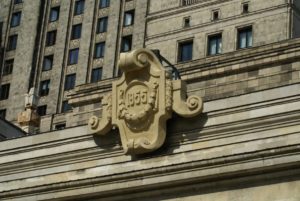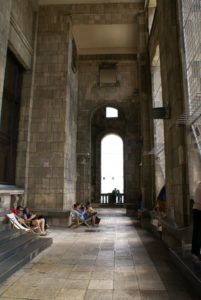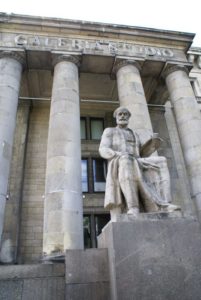By Agata Szostkowska
The tallest building in Poland, the eighth tallest building in the European Union and in a Top-20 in Europe. There has been no more foreground building constructed in Poland after 1945 than the Palace of Culture and Science – or to give it its full title: “the Palace of Culture and Science in the name of Joseph Stalin”. And none more divisive and controversial, either.
They should have sold it and said they would ship it over for free
When I told my English friend I was going to write a text about the Palace of Culture and Science, he asked me if I was talking about „a monstrously hideous landmark in the centre of Warsaw”. It is very tasteless on a Soviet Communist way – he said. I am surprised people who suffered under communism don`t want it torn down – he added. I told him an American billionaire wanted to buy the Palace a while ago and move it to the States, unfortunately Poland disagreed but my friend was unconvinced and replied: They should have sold it and said they would ship it over for free!!!
As the city’s most visible landmark, the building was controversial from its inception. Many Poles initially hated the building because they considered it to be a symbol of Soviet domination, and at least some of that negative feeling persist today. Some have also argued that, regardless of their political connotations, the building destroyed the aesthetic balance of the old city and imposed dissonance with other buildings. This contrast has been lessened somewhat over the years with the construction of several skyscrapers in the vicinity. Despite the controversies, the Palace became an internationally recognized symbol of Warsaw.
The Palace was meant to fascinate the public but instead became the subject of several jokes and sarcastic observations. The French actor Gerard Philipe while visiting Warsaw called the Palace „small but tasteful”. There was a running joke about the most beautiful place in Warsaw and the answer was „the 30th floor of the Palace of Culture and Science since there was a viewing tarrace and standing there you could see anything but the Palace”.
The nicknames full of hate and contempt
Varsovians still commonly use nicknames to refer to the Palace, notably Pekin (“Beijing”, because of its abbreviated name PKiN), Pajac (pronunciated as „payatz”, “clown”, a word that sounds close to „pałac”). Other less common names include Stalin’s syringe, the Elephant in Lacy Underwear, or even the Russian Wedding Cake. The building has been most hated by Warsaw inhabitants since it was a gift from the loathed Soviet Union to the people of Poland.

The Legends about the Palace of Culture and Science
There are many legends about what is hidden beneath the building: fallout shelter, railway platform, pathways to Warsaw Central Station (opened 20 years later) and the House of the Party, the seat of The Polish United Workers’ Party (PZPR being the Communist party which governed the People’s Republic of Poland from 1948 to 1989). The PKiN information desk informed me last weeked there was not fallout shelter under the building however I remember one of my student mates mentioned shooting session made there nearly 30 years ago.
The other legend says a Polish Communist leader, NKVD agent, and a hard-line Stalinist who became President of Poland Bolesław Bierut held talks with the leader of the Soviet Union Joseph Vissarionovich Stalin which led to accepting the Palace of Culture and Science as a new building in Warsaw city`s centre. Poland was offered a rapid transit or a palace and its preference was for the latter. Maybe that`s why Warsaw was waiting for the former for several dozen years,
Gift of the Soviet people to the Polish nation
The Palace of Culture and Science has been built in a mixture of then-compulsory Socialist realism with elements of Polish historicism. It stands for everything Poland tried to reject after the fall of the Berlin Wall in 1989 and the swift crumbling of the Soviet Union, and better than any other building it epitomises the 44 years of the People’s Polish Republic.
Construction started in 1952 and lasted until 1955. The Palace was a cornerstone of the Warsaw to come, planned together with a majestic Parade Square. During construction it was still surrounded by post-war ruins, with people living in tenements cut in half by bomb craters, survivors of Warsaw’s razing by the Nazis in 1944.
The palace was a “gift of the Soviet people to the Polish nation”, offered by Joseph Stalin himself. The architect was Lew Rudniew. The tower was constructed, using Soviet plans, almost entirely by 3,500 workers from the Soviet Union, of whom 16 died in accidents during the construction. One of the legends, more horrible than the others, said the corpses were buried into foundations of rising palace. In fact those 16 labours were inhumed in the orthodox cementary.
It may have been Stalinist madness to build such an ostentatious palace while the rest of the city barely existed. But one can also imagine this new building bringing hope and inspiration to a city being transformed, not just physically but socially. Thousands of people came from across the devastated country to help rebuild the capital.
The architecture of the building is closely related to several similar skyscrapers built in the Soviet Union of the same era, most notably the Moscow State University. However, the main architect Lew Rudnev incorporated some Polish architectural details into the project by traveling around Poland and seeing the architecture. The monumental walls are headed with pieces of masonry copied from Renaissance houses and palaces of Kraków and Zamość. Rudnev’s grand idea for the palace was an eclectic mix of Russian baroque and gothic details on a steel-framed tower. To call Socialist realism eclectic is, of course, heresy – officially it was to be “socialist in content, national in form”.
The palace’s exterior was also extremely elaborate. It is surrounded by dozens of monumental sculptures in the classical style of Michelangelo’s ignudi, including astronomer and mathematician Copernicus, Romantic poet Adam Mickiewicz, pioneering physicist Marie Curie, as well as idealised model workers – the most famous one holding a Ten Commandments-style book inscribed with the names of Marx, Engels and Lenin (Stalin’s name was carefully removed after 1956).
The Palace shocks equally from the interior with marble floors and endless staircases and corridors that dazzle with their weighty glass chandeliers and gilded finishings. Like the famous Moscow metro system, this was luxury for the masses. And that`s what differentiated the palace from its Muscovite cousins was its entirely public use – it was designed to hold several museums, theatres and sports venues.

The legendary gigs inside the gift of the Soviet people to the Polish nation
The Congress Hall (Sala Kongresowa) and Concert Hall (Sala Koncertowa) are without a doubt among the most important concert halls in Poland. The former is by far the bigger of the two: it can accommodate up to 2,880 persons, while the second holds only 550 people, but is now one of the best-equipped in the country in terms of modern technology.
Shortly after opening, the building hosted the 5th World Festival of Youth and Students. Many visiting dignitaries toured the Palace. The Congress Hall has seen numerous prestigious acts of guest artists over the years, such as Marlene Dietrich, Procol Harum, Bruce Springsteen, Cesaria Evora and Woody Allen with his band. It also hosted performances, such as a 1967 concert by the Rolling Stones, the first by a major western rock group behind the Iron Curtain. In 1985, it hosted the historic Leonard Cohen concert, surrounded by many political expectations, which were avoided by Cohen in his prolonged introductions during the three-hour show.
A tape recorder pressed on the belly
March 22nd, 1985. I will remember that day for ever. My mother and I were waiting outside The Congress Hall waiting for a concert. The legendary gig by Leonard Cohen. It was terribly crowded. The public was not allowed inside and militia watched over. I must say I was a reckless young lady. The crowd pressed forward. I brought a tape recorder with me. Who cared about copy rights in the People’s Polish Republic? Almost nobody. But I don`t remember if they allowed me to record the performance. It was so crowded I felt the tape recorder pressed on my belly. It was too much for me. I was 19, I had head full of high ideas, and I decided to tell militia I disliked everything happening there. My mother couldn`t prevent what happened next. I started arguing with militia men. I behaved like someone who came from the outer space and didn`t understand people always were treated worse than cattle rushed into fields. My mother tried to calm me down droning that I supposedly lost my mind again but my argument with militia had a very good result. They made a kind of aisle and let us go inside.
Where you can see anything but the Palace
We have got to the point – the joke I told you before. Which place is the most beautiful in Warsaw? The viewing terrace. Why? Because you can see anything but the Palace.
The big attraction for tourists and residents is the ‘trzydziestka’, a large terrace on the 30th floor of the Palace (at a height of 114 m), where you can admire the gorgeous panorama of Warsaw. On New Year’s Eve, 2000, the Palace of Culture and Science unveiled the second-largest clock in Europe. Its four discs are each 6 m in diameter, and it is highest clock tower in the world.

***
The Palace of Culture and Science was finished 10 years after the end of the WWII, which both destroyed and transformed Poland. What came after was the greatest challenge in the country’s history – to this day, people can’t decide whether it was a failure, or a success. My English friend whose words I was quoting said at the end of our talk: „It will hopefully be torn down one day and replaced with something more fitting”. But would demolishing the palace destroy any memory of communism, with Poland’s image emerging cleaner and more innocent as a result? Do memories work like that? Despite occasional threats of demolition – or privatisation – it is simply too big, too statuesque and too symbolic to get rid of in any organised manner.
No matter whether the Palace stands for ever or has an expiry date it is worth seeing because it is a perfect mix of the most hideous and the most gorgeous things you have ever seen.


Photos @Michał Stanisławski
Source: https://www.communications-unlimited.nl/gift-of-the-soviet-people-to-the-polish-nation/


Follow Us!